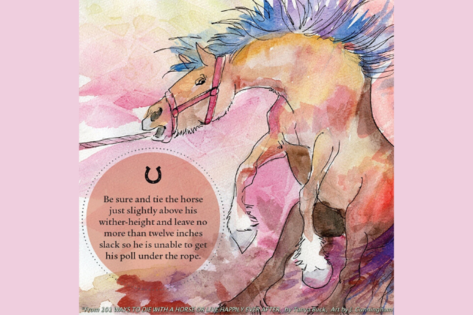
The Most Popular Horse Breeds Of 2019
Equestrian Advice & Guides General Equestrian
Build your business profile for FREE and expose your services to thousands of potential clients!
Create my profile now!
“My horse won’t stand tied. He pulls back hard until he’s sitting! He’s doing it on purpose to get out of work and with the great advice I got on Facebook, now I can fix his little red wagon!”
This was what I overheard at the feed store, today; the woman ahead of me was telling the cashier a story about how her horse was tied, then pulled back, broke his lead and ran off. She caught her horse, retied him, he did the same thing again and she believed that since he’d now “gotten away with it,” he was now sure to do it every time he was tied, and he would do so on purpose, escaping, running and frolicking to his heart's content. The owner was certain this horse now was plotting his next way to behave badly. She was convinced the horse’s bad behavior was intentional and that next time she tied him, he’d pull back harder so he could break the halter, thereby costing her more money and he would get out of work.
I peeked around to see what she was buying; a new rope halter, a bungee lead, a stud chain and a whip.
I so wanted to talk to her, to offer help, but she was angry and intent on “teaching her horse a lesson” by following the advice she’d gotten on Facebook. I feel guilty for not stepping up, but I know that when advice is unsolicited, it is also unwelcome and not followed. I’m haunted with worry about the “training” that the horse will endure.
The thing that most people fail to consider is that the act of sitting back while tied is a horse’s direct response to something because his actions are his only way of communicating with us. Bad or good behavior never comes out of the blue and is never a plot by the horse to get out of work. It can be, simply, that the horse was never taught to tie, or has had a bad experience while tied, and so feels panic at his inability to move freely. Having no other choice, he fights to get away. Once he understands that he’s captured and not able to move, he literally freaks out and fights the pressure around his poll and head by trying to get away—and why I never tie a horse wearing a rope halter, the rope and knots cut into and cause serious harm to sensitive facial nerves. With that much power and weight involved, something must give, and if the rope, snap, halter or hitching post doesn’t, his neck will. I’ve only (luckily) ever seen one horse break his neck by pulling back and it was a long time ago when I was a child; I promise you, I’ve never forgotten the sight of that horse hanging by his rope, dead.
The habit is dangerous, so how do you stop a horse from sitting back when tied?
The answers the Facebook people came up with are the usual run-of-the-mill expected response, and ranged from bigger ropes, various tying mechanisms, magical halters, videos to watch, snub posts, blocker ties, bungees, and so on. One brilliant response was to use three halters and another was to use a chain halter. One humane human thought tying the horse up with hoses that had chains inserted into them and leaving said horse tied overnight “if it took that long” would forever and always cure them. Yet another person suggested tying the horse to her own waist and running toward him as he was running backward. Brilliant does not begin to convey my own appraisal of these suggestions.
We can all agree that teaching a foal to tie is critical, just as teaching him to lead is one of the most important lessons he’ll learn. But how do you retrain a full-grown, explosive, 1,100 pound horse not to pull back?
Here's the checklist on how I retrain the horse to tie; how I have done it and how I will continue to do it, although more often, I use Clicker Training instead as it’s faster and easier.
But how do we retrain the horse? The nuts and bolts of the session look something like this:
Obviously, this is not a one-day wonder lesson, but it does work about 95% of the time. Another method I like to use is to Clicker Train at liberty before adding a halter and rope. This method has never failed me and is fun for both horse and human. Look for this subject in my next post. Until then, practice tying without tying and post your success here. Remember, it takes longer to retrain than to train correctly in the beginning.
Today’s FREEBIE is Original Artwork from 101 WAYS TO DIE WITH A HORSE OR LIVE HAPPILY EVER AFTER, by Tanya Buck! Just click here to sign up for other periodic freebies. (I will very seldom send out updates on books, deals and free stuff like tips, art or free eBooks. Just click this link to get yours! https://lp.constantcontact.com/su/ajYbjFB
Happy Training!
~Tanya Buck
Questions? Comments? Contact me directly here: TanyaBuck.com

